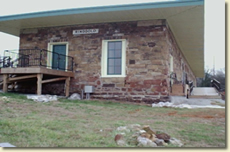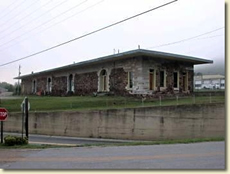The
Stone Depot of the Western and Atlantic Railroad is located
on the east side of the Railroad track in downtown Ringgold.
This area is shown on the Ringgold, GA quadrangle of the
U. S. Geological Survey maps.
HISTORICAL
BACKGROUND
The coming of the Western and Atlantic Railroad and the
construction of an impressive stone depot in 1849 had a
great influence on the growing economy of Ringgold and the
surrounding area. The railroad business was so good that
a second station, or freight platform, called Catoosa Station
was constructed just south of the gap. Ringgold was on the
way to becoming the most prosperous town in north Georgia.

The Western and Atlantic Railroad Station at Ringgold,
commonly called The Stone Depot.
The depot was struck by a few cannon balls during Federal
shelling on September 11, and again on September 17,1863.
During the Battle of Ringgold Gap, on November 27, 1863,
the depot was in the center of the action. General Joseph
Hooker spent the entire battle sitting on a cracker barrel
behind the stone walls.
When
General Grant left Ringgold, following the battle at the
gap, he instructed Hooker to destroy anything of military
value to the Confederates, but cautioned against wanton
destruction. Hooker passed on the orders to General John
Geary. In his official report, Geary mentioned only military
targets, but in a candid letter to his wife he stated: I
burnt Ringgold because the enemy fired upon us from the
houses. It contained about 5,000 inhabitants and was a beautiful
place I feel I have performed my duty. We betide the rebels
whenever I can get my hands on them.
|

The stone depot at Ringgold.
The
historian of the 149th New York Infantry Regiment provided
a detailed account of the manner in which General Geary did
his duty. War is a dreadful calamity to any country, he wrote,
and inflicts misery, not only upon the soldier and his family,
but upon all with whom it comes in contact. It spares not
young, nor old, weak, nor strong, and sacrifices public and
private property alike to its purpose. The day before the
troops were withdrawn from Ringgold the destruction of that
village was ordered as a military necessity and the execution
of this unpleasant duty was entrusted to Capt. Ira B. Seymour,
the provost marshal and his guard. In the afternoon, the families
were removed to vacate the buildings in the suburbs and at
midnight the fiery torch was applied. When the troops arrived
on top of the hill, west of the Chickamauga River, they beheld
the flames ascending from the river bridge, the depot, the
gristmills, hotel, brick blocks, and public and private buildings
and the frantic efforts of the people as they strove in vain
to stay the ravages of the fiery element their little belongings.
After a little [while] a dense column of smoke, brick and
burning debris suddenly ascended heavenward from the court
house in the center of the town, followed by a deep intonation
on the midnight air, showing that the powder main had taken
effect, and the destruction of fair Ringgold completed. It
was a sad and fearful sight, yet was only the precursor of
others still more terrible to follow before the rebellious
people of the South were subjected.
While
the powder that been placed in the depot did some damage,
the structure did survive. The patches in the walls were damaged
stones were replaced can still be seen today. The depot has
been fully restored and landscaped and can be viewed by the
public.
|
References:
Official Records of the War of the Rebellion
Archive and files Chickamauga and Chattanooga National Military
Park
Chattanooga Area Civil War Sites Assessment
Bill Clark, History in Catoosa County
Raymond Evans, Cleburnes Defense of Ringgold Gap
Significant
Views: There is an excellent viewshed for this structure
from the street. The interior can be seen by appointment.
Setting:
The depot is located beside the modern train tracks in the
city of Ringgold. The grounds are landscaped to a park like
condition.
Documented
Structures, Sites and Features: The depot is a large rectangular
structure.
Presumed
Wartime Features: This was a working train station on
the Nashville and Atlantic Railroad during the war. It was
a central feature in the battle of Ringgold Gap.
Original
Terrain: The general terrain in the vicinity of the depot
has much of its wartime appearance.

The stone depot.
Related
Sites: Catoosa Station and Ringgold.
|